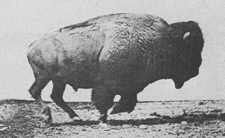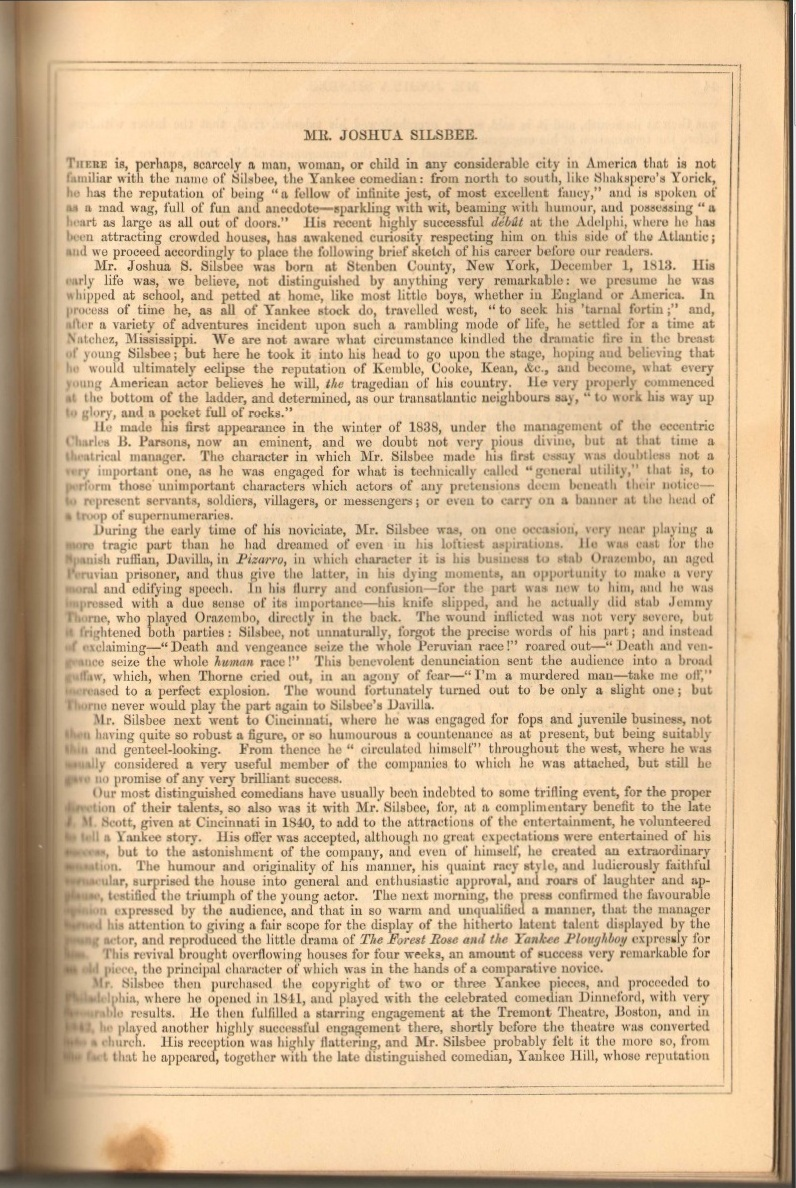
An enthusiastic British review.
“The Drama,” Weekly News and Chronicle (Middlesex UK), Saturday, 27 September 1851, p 539 col 1:
An unenthusiastic British review.
The Atlas, Saturday, 27 September 1851, p 619:
Littell’s Living Age, vol 31, (Boston: E Littell & Co, October, November, December 1851), p 288:
Another unenthusiastic British review.
Lloyd’s Weekly Newspaper no 462, Sunday, 28 September 1851, p 10:
The American Magazine (London) 1 no 1, October 1851, pp 53–43:
Eye-catching advertisements.
The Atlas, Saturday, 11 October 1851, p 655:
The Atlas, Saturday, 18 October 1851, p 671 col 1:
Foreign Items by Steamer Humboldt.
The Huron Reflector (Norwalk, Ohio), Tuesday, 20 October 1851, p 3 col 1:
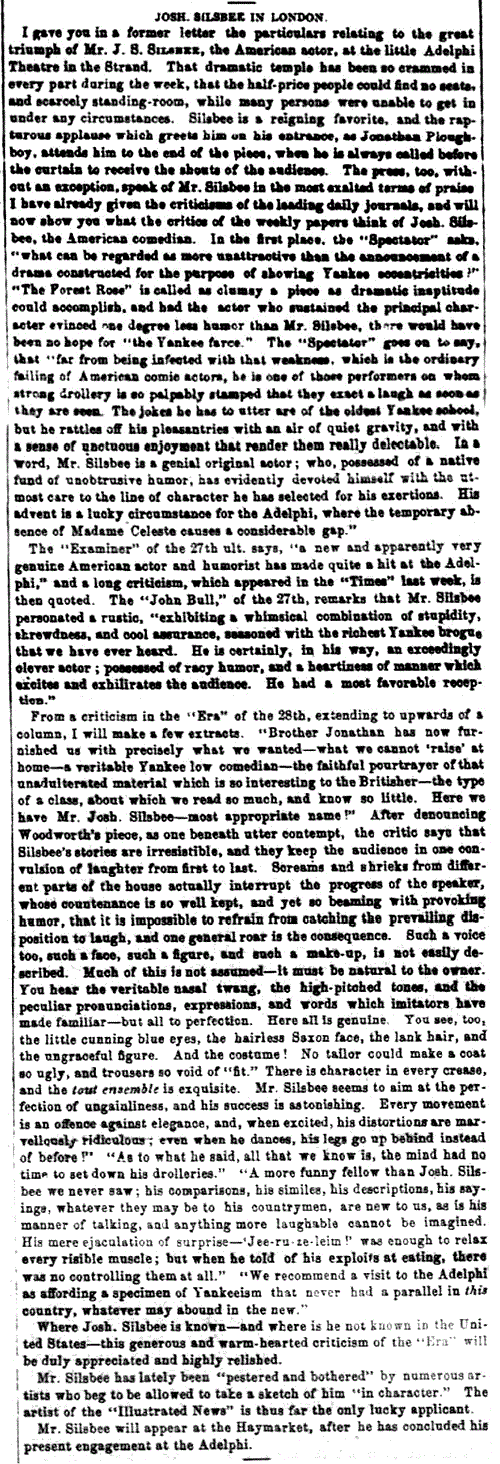 Zo, we must find this Illustrated News, yes?
Zo, we must find this Illustrated News, yes?
The New-York Evening Post, Monday, 27 October 1851, p ? col 3:
The Spirit of the Times: A Chronicle of the Turf, Agriculture, Field Sports, Literature and the Stage 21 no 38, Saturday, 8 November 1851, p 1 col 2:
The American Magazine (London) 1 no 2, November 1851, p 112:
More eye-catching advertisements.
The Atlas, 15 November 1851, p 734:
The Atlas, Saturday, 29 November 1851, p 766:
The American Magazine (London) 1 no 3, December 1851, pp 225–226:
The Cape Cod Reel.
Mention was made above to Silsbee’s peculiar rendition of the “Cape Cod Reel.”
Predictably, the published script from 1855 says nothing at all about any “Cape Cod Reel.”
So that was Josh’s addition, along with the extra interpolations concerning coaxing the unwary out of small sums
and his droll stories and Jonathanisms.
Back to the dance:
This reel must have been a popular dance, though I have no clue how this was played or how it was danced,
and I certainly don’t know how Josh induced merriment by dancing it in his own strange similar-to-Hackett’s style.
But some Internet searches revealed a little bit. Very little.
The ever-hostile Lloyd’s.
Lloyd’s Weekly Newspaper, Sunday, 7 December 1851, p 11 col 1
A clue? A clue? Is this a clue?
The piece on the Lord Chamberlain is, of course, a satire.
Nonetheless, it contains a statement that might serve as a clue.
If the anonymous author stated the truth about the necessity of all script changes being submitted to the censor’s office,
then we know where to look for Josh’s acting scripts!
Punch, Vol XXI, 1851, pp 164_272:
Transmuting Hollowness into a Sterling Fund of Amusement.
The Weekly News and Chronicle, Saturday, 17 January 1852, p 44 col 1:
The Yankee Peddler is superior to The Forest Rose.
Bell’s Life in London and Sporting Chronicle, Sunday, 18 January 1852, p 2 col 5:
The American Magazine (London) 1 no 5, February 1852, p 281:
The American Magazine (London) 1 no 5, February 1852, p 282:
Josh Silsbee is at the Amphitheatre, and will soon appear at the Princes Royal.
Lloyd’s Weekly Newspaper, Sunday, 7 March 1852, p 7 col 2:
Josh Silsbee at the Princes Theatre, Glasgow.
Lloyd’s Weekly Newspaper, Sunday, 21 March 1852, p 11 col 2:
A serial publication: “Silsbee’s Yankee Stories.”
Bent’s Monthly Literary Advertiser, Monday, 12 April 1852, p 75:
Josh Silsbee returns to the Adelphi, November 1852.
Bell’s Life in London and Sporting Chronicle, Sunday, 14 November 1852, p 7:
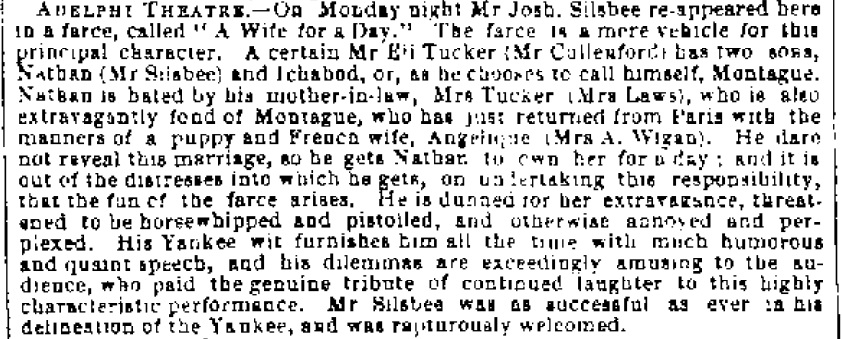

Josh Silsbee’s Benefit Performance in Wolverhampton, January 1853.
As one can see from the
Wolverhampton Archives
there is on file a broadside for Josh’s benefit performance of Friday evening, 7 January 1853,
at the Theatre Royal, Wolverhampton.
As usual, several items were on the bill,
chief among them Josh Silsbee’s starring rôle
as Jedediah Homebred in Green Mountain Boy.
What makes this interesting is the description:
“an entirely new Comedy, in two acts, (written expressly for Mr. Josh Silsbee, by J. S. Jones, Esq.).”
Now, that’s a most curious claim,
for George Handel Hill had first played Jedediah Homebred
in Joseph Stevens Jones’s Green Mountain Boy in 1833.
Oh well.
There are several possibilities here.
First, perhaps those who were producing the play in Wolverhampton lied,
and simply hoped that audiences would prefer to enjoy the show rather than stay at home fact checking on the Internet.
Second, perhaps this was a mistake.
The third possibility is slim, to say the least,
though we should not discount it until more evidence can be found.
George Hill had passed away, and Josh Silsbee quickly purchased the rights to the plays that he owned.
Joseph S Jones was still alive and active, and Josh would have had to deal with him.
It is possible that Joseph worked with Silsbee to adjust Jedediah’s dialogue better to fit Josh’s stage persona.
But really, who knows?
It would be wonderful to compare George’s acting script with Josh’s,
but it is difficult to know which version of the script was published and how it differed from other versions.
Well, can’t please everybody.
As Buster Keaton once said, “This critic likes you, and that one don’t.”
Lloyd’s London Newspaper, 8 May 1853, p 8 col 4
You should click on
the above link to see the entire page so that you can read column 1.
It is overflowing with sentiments about what to do with the Californian natives.
These plans seemed reasonable in the 1850’s,
at least to some people,
but now many of us recognize such ideas as genocidal at best:
“...the Indians will be transformed from a state of semi-barbarism,
indolence, mental imbecility and moral debasement,
to a condition of civilization, Christianity, industry, virtue, frugality,
social and domestic happiness and public usefulness....” Uh, yeah.
Well, that’s sure what a lot of (white) folks in Buffalo still think....
Here’s a letter that Josh Silsbee wrote to “Mac.”
Who was Mac? Above we saw that he autographed two portraits to a “McKean,”
whom I suspect was really “McKeon,” whom you will meet later, below.
Mac/McKean/McKeon — all the same person? I don’t know.
(Original on file in the The Simon Gratz Collection at the Historical Society of Pennsylvania):
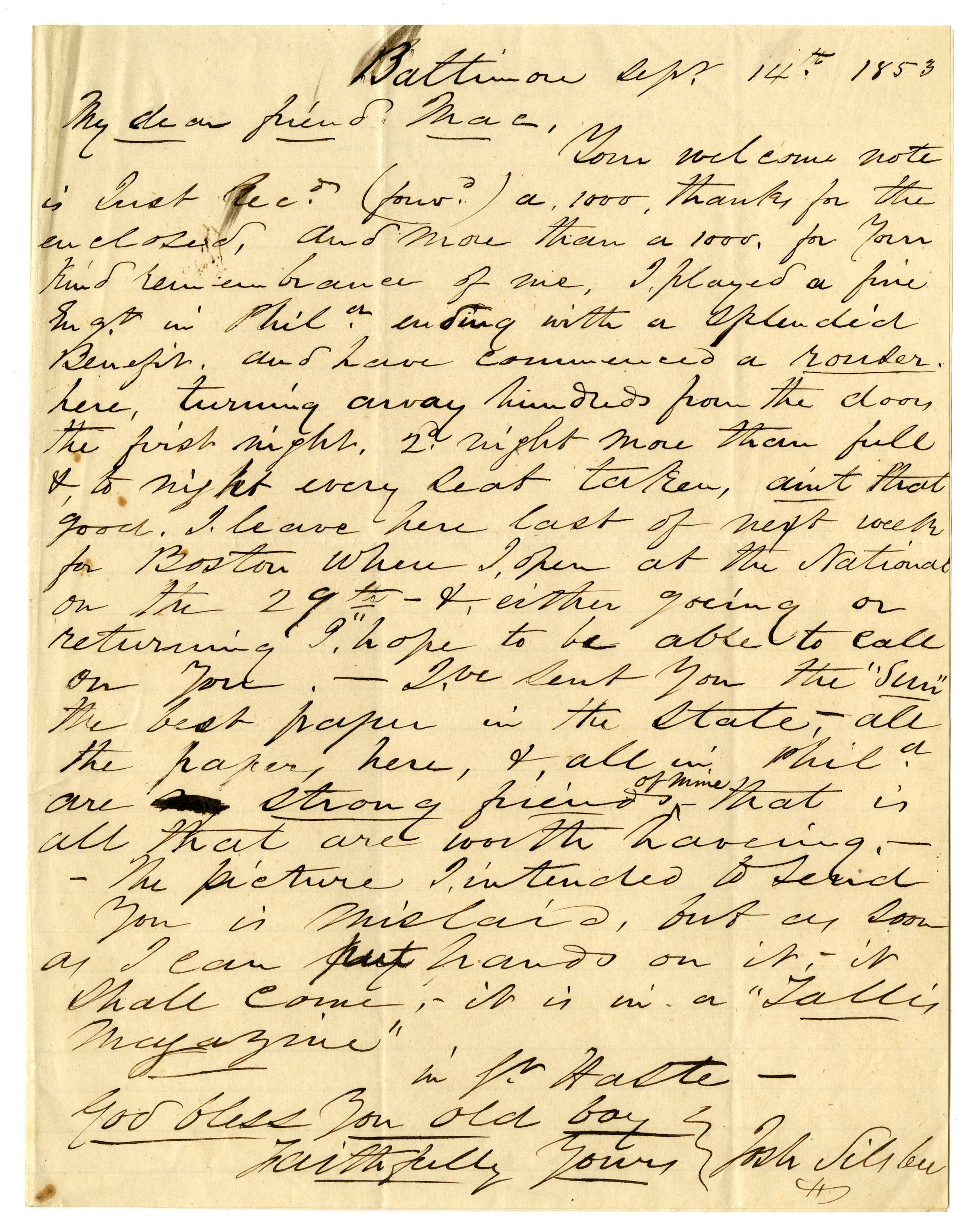
From The Simon Gratz Collection [2050B], DAMS 6593, Box 254, Folder 39
The Historical Society of Pennsylvania
Rights and Reproductions
1300 Locust St
Philadelphia PA 19107-5661
Tel 215 732 6200 ext 333
Fax 215 732 2680
rnr@hsp.org
Reproduced by permission.
Please do not copy further.
[License expires 22 September 2021]
If you had trouble reading that, here is my transcription: |
|
Baltimore Sept 14th 1853
My dear friend Mac,
Your welcome note
is Just Recd (foura) a, 1000, thanks for the
enclosed, And more than a 1000, for Your
Kind rememberances of me. I played a fine
night in Phila ending with a splendid
Benefit, and have commenced a rouser
here, turning away hundreds from the doors
the first night. 2d night more than full
&, to night every seat taken, aint that
good. I leave here last of next week
for Boston where I open at the National
on the 29th – &, either going or
returning I hope to be able to call
on You. — I’ve sent You the “Sun”
the best paper in the State,– all
the papers here, &, all in Phila
are strong friends of mine – that is
all that are worth haveing. —
– The picture I intended to send
You is mislaid, but as soon
as I can put hands on it,– it
shall come,– it is in a “Tallis
Magazine”.
In ∫t Haste —
God bless You old boy
Faithfully Yours
Josh Silsbee
|
Josh Silsbee in Boston, October 1853.
Note the name Fleming. That was Mr William M Fleming (1817 – 6 or 7 May 1866).
He pops up elsewhere, as we shall see.
Bell’s New Weekly Messenger (Middlesex, London, England), Sunday, 23 October 1853, p 5 col 6:
Josh Silsbee at Connor’s Theatre, November 1853.
I’m not sure, but I think this was the Connor’s Theatre in Albany.
Bell’s New Weekly Messenger (Middlesex, London, England), Sunday, 20 November 1853, p 5 col 6:
The Daily Alta California 6 no 96, Friday, 13 April 1855, p 2 col 4:
The Daily Alta California 6 no 98, Monday, 16 April 1855, p 2 col 4:
The Daily Alta California 6 no 99, Tuesday, 17 April 1855, p 2 col 3, p 3 col 2
(Mrs F M Kent?!?!?!?!?):
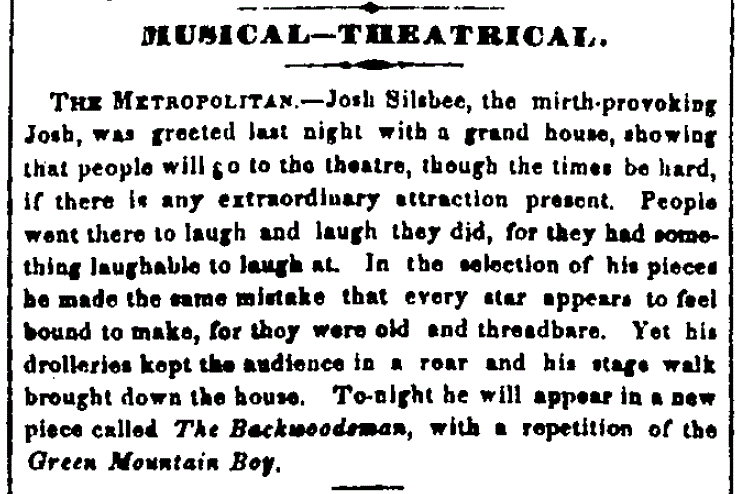
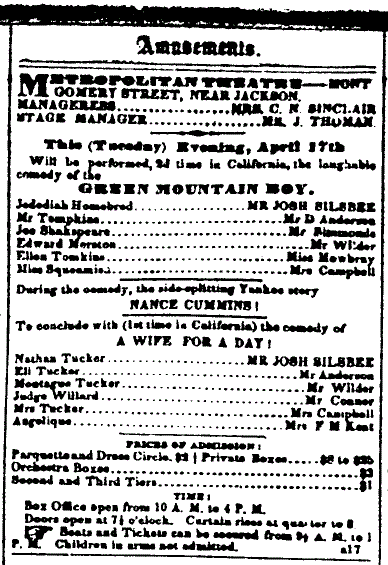
Because almost all of us are generally suspicious and cynical
(except when we listen to Oprah or miracle-workers or fortune-tellers
or law-enforcement officers or get-rich-quick gurus)
we all just know that the above is shameless publicity hype.
But because, speaking for myself, I’m not generally suspicious and cynical
(except when I listen to Oprah or miracle-workers or fortune-tellers
or law-enforcement officers or get-rich-quick gurus)
I have a different take on this.
The management here effectively admit that previous shows were flops,
but that Josh Silsbee filled the house.
As we shall see below, management would again freely admit to flops and empty houses.
This would never happen nowadays, but in San Francisco at the time,
where almost all recorded deaths were of people in their 20’s and 30’s,
where earthquakes regularly made people homeless and moneyless,
where banks had a frequent and nasty habit of going bust without warning,
there was no real reason to pretend that all was well.
And note the San Francisco prices! Sheesh!
In the rest of the country the usual prices were 25¢ and 50¢.
Not in San Francisco!
Goodness gracious! What on earth was going on there? My heavens!
Well, on the other hand, that’s still the case there, isn’t it?
The ticket prices are probably what lured thespians to the Bay Area.
But the unhealthful conditions, as demonstrated by the death records,
which generally showed that all deceased were youths,
should have been enough to warn people away.
It should have warned Josh away.
The Daily Alta California 6 no 100, Wednesday, 18 April 1855, p 3 col 2:
The Daily Alta California 6 no 101, Thursday, 19 April 1855, p 3 col 2:
The Daily Alta California 6 no 102, Friday, 20 April 1855, p 2 col 6, p 3 col 2:
The Daily Alta California 6 no 103, Saturday, 21 April 1855, p 3 col 2:
The San Francisco Daily Herald, 5 no 324, Sunday, 22 April 1855, p 2 col 8:
The Daily Alta California 6 no 104, Monday, 23 April 1855:
The Daily Alta California 6 no 105, Tuesday, 24 April 1855, p 2 col 6:
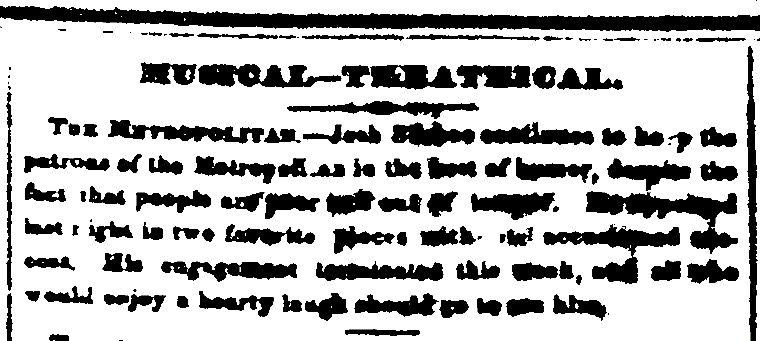 Oh phooey! That’s hard to read. Here’s what it says:
Oh phooey! That’s hard to read. Here’s what it says:
The Daily Alta California 6 no 106, Wednesday, 25 April 1855, p 3 col 2:
The Daily Alta California 6 no 107, Thursday, 26 April 1855, p 3 col 2:
The Daily Alta California 6 no 108, Friday, 27 April 1855, p 3 col 2:
The Daily Alta California 6 no 109, Saturday, 28 April 1855, p 3 col 2:
The San Francisco Daily Herald 5 no 331, Sunday, 29 April 1855, p 2 col 1:
After the Saturday-night performance,
Josh hit the road again, and played, I think, Sacramento and various other locales in that general area.
Then he came back for a special occasion:
The Daily Alta California 6 no 144, Friday, 8 June 1855, p 2 col 5;
repeated in The Daily Alta California 6 no 145, Saturday, 9 June 1855, p 2 col 6:
I presume he went on the road again after that gig.
Next is a press release entirely unrelated to Josh Silsbee,
but I post it here merely to prove my point about the surprisingly honest advertising in San Francisco in the mid-1850’s.
The Metropolitan Theatre openly admits that its recent shows were all boxoffice failures.
The Daily Alta California 6 no 153, Tuesday, 19 June 1855, p 2 col 4:
The Unexpectedly Sudden.
The San Francisco Daily Evening Bulletin Saturday, 22 December 1855, p 3 col 1:
The official registry listed the cause of death as chronic dysentery, 22 December 1855.
The registry gave the date of the entry on the 23rd, rather than the date of death on the 22nd.
Josh bequeathed his entire estate to Martha.
Probate.
The San Francisco Daily Herald, Monday, 31 December 1855:
State of California, County of San Francisco,
ss in Probate Court..........notice is hereby given that James E. Wainwright and James Stark,
residents of the City and County of San Francisco,
have this day presented and filed in said court an instrument in writing and their petition,
asking that the said instrument be admitted to probate as the last will and testament of
Joshua S. Silsbee ,
deceased..........San Francisco, Dec 24, 1855, attest:
Thomas Hayes, county clerk.
Alexander Campbell, attorney. dec 25 2 aw td
|
The New York Herald, 26 January 1856, col C.
(Much modern
scholarship, such as that by
Francis Hodge and the various capsule biographers,
seems to have used the judgments in this obituary as definitive. Oops.):
|
JOSH SILSBEE, COMEDIAN.
We hear by telegraph from New Orleans that the well known comedian whose name heads this notice died at San Francisco,
about the 20th of last month.
Mr. Silsbee was a native of the town of Wayne, in the county of Steuben, in this state,
and made his first appearance in a Yankee comedy at the Albany theatre, about ten years since,
and afterwards played at the Chatham.
In 1850 [wrong! 1851]
he went to London and made his debut at the Adelphi as Jonathan Ploughboy, in
“The
Forest Rose.”
Mr. Silsbee was much liked in London, and played at the Adelphi through nearly two seasons.
Returning to America, he played his first engagement at the Broadway theatre, commencing the season of 1853.
He did not please his own countrymen so well as the Londoners
[contrast this with his letter to “Mac” above] —
his portraitures being very broad caricatures, and making the Yankee character too gross and monstrous.
He had a round, jolly face and much mobility of countenance.
He was often excessively funny, and evidently possessed the elements of his art.
He needed taste and a good school.
He was, however, quite equal to Hill, whom he imitated, but inferior to Marble or Burke.
He travelled through the country during the season of ’53 and ’54,
and went to California about a year since.
He was only moderately successful in the Golden State
[wrong! check this claim against the press cuttings above],
and we heard some time since that his health was impaired.
Mr. Silsbee was about thirty-five years of age [wrong! he was forty-two].
His personal character was above reproach;
he was a worthy, quiet, conservative, temperate, prudent man, and had, we learn, secured a handsome competence.
He leaves a widow and children.
There seems to be a mortality among the “Yankee comedians,” so called.
Messrs. Marble, Hill and Burke all died young.
The only representative of this style of part that we know of now is Mr. McVicker,
who recently arrived here from a European tour.
|
Capsule Biographies and Various Reminiscences (the newer they are, the worse they are):
Answers.com:
Francis Courtney Wemyss [pronounced Weemz], Chronology of the American Stage from 1752 to 1852 (New York: Wm Taylor & Co), p 134:
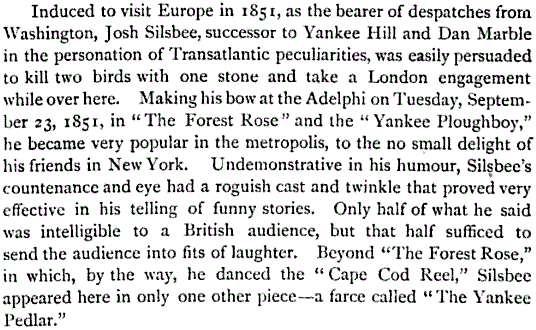
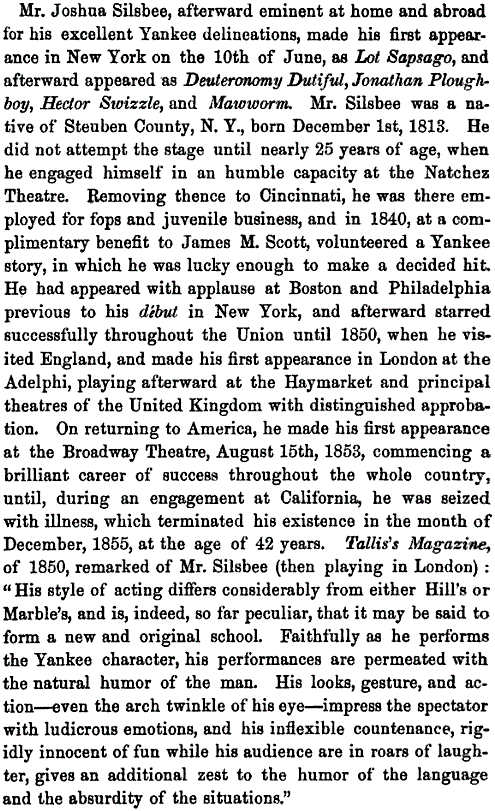
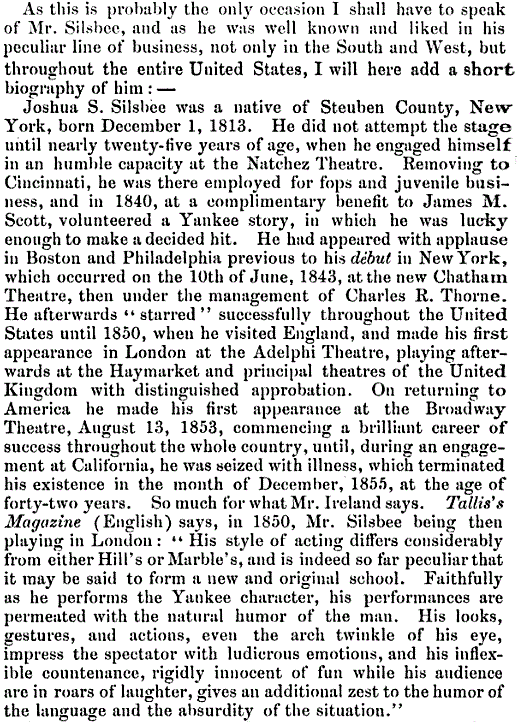
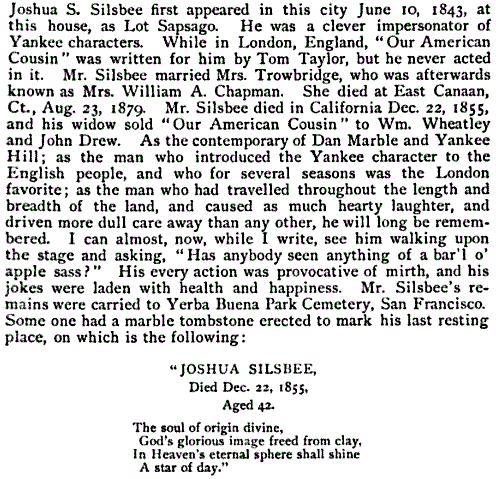
By the way, since Josh Silsbee was famous as a Yankee comic,
and since he was a master of the “Yankee” accent,
here’s a project that I rather suspect no one has done yet,
though I hope I’m wrong —
I would be most delighted to discover that there are reams of research on this topic.
Those who travel through the Finger Lakes Region of Central New York
will be surprised to hear some of the locals sound almost as though they’re from the Carolinas.
The accent is quite distinctive and definitely akin to the accents Down South.
This is a remnant of the original Upstate New York accent(s?),
and sadly, thanks to television, highways, rock music, and far too many outsiders moving in to create abominations known as ‘suburbs,’
the accent is near to extinction.
The accent needs to be recorded and studied, for it holds a clue to our linguistic history,
and it also holds clues to our theatrical history.
If no one has done that yet, well, college students, there’s your PhD thesis. Go for it.
I am almost certain that the outrageous accent Josh Silsbee capitalized on in his shows
and in his endless series of pranks
was merely a grotesque exaggeration of his own accent as well as of the rival city accents.
Children: As we saw above, the obituary in
The New York Herald of 26 January 1856 mentioned that Josh Silsbee
“leaves a widow and children.”
Yet the 1850 census indicated that Josh and Martha, who were residing at a boarding house in Philadelphia,
did not have any children with them, except for a Frances Silsbee, age 15, too old to have been child of their own wedlock.
She was certainly a relative, though.
There were no Trowbridges listed as living with Josh and Martha as of 1850.
Of course, there is a chance that Frances Silsbee had originally been Frances Trowbridge.
Her age certainly matches that of the child that Mr & Mrs Trowbridge brought into the world in early 1835.
So that might be one child, but not children.
The “children” referred to in the Herald were probably stepchildren inherited from Mr Trowbridge,
names and whereabouts unknown.
By 1855 they had grown and were probably living on their own.
Remember we mentioned Thomas McKeon above?
Take a look at Thomas Allston Brown,
History of the American Stage
(New York: Dick & Fitzgerald, Publishers, 1870), p 230:
Below is a letter that William Adams Chapman wrote on 3 April 1855, almost surely addressed to Thomas McKeon.
There’s something written on the back.
Let’s take a look:
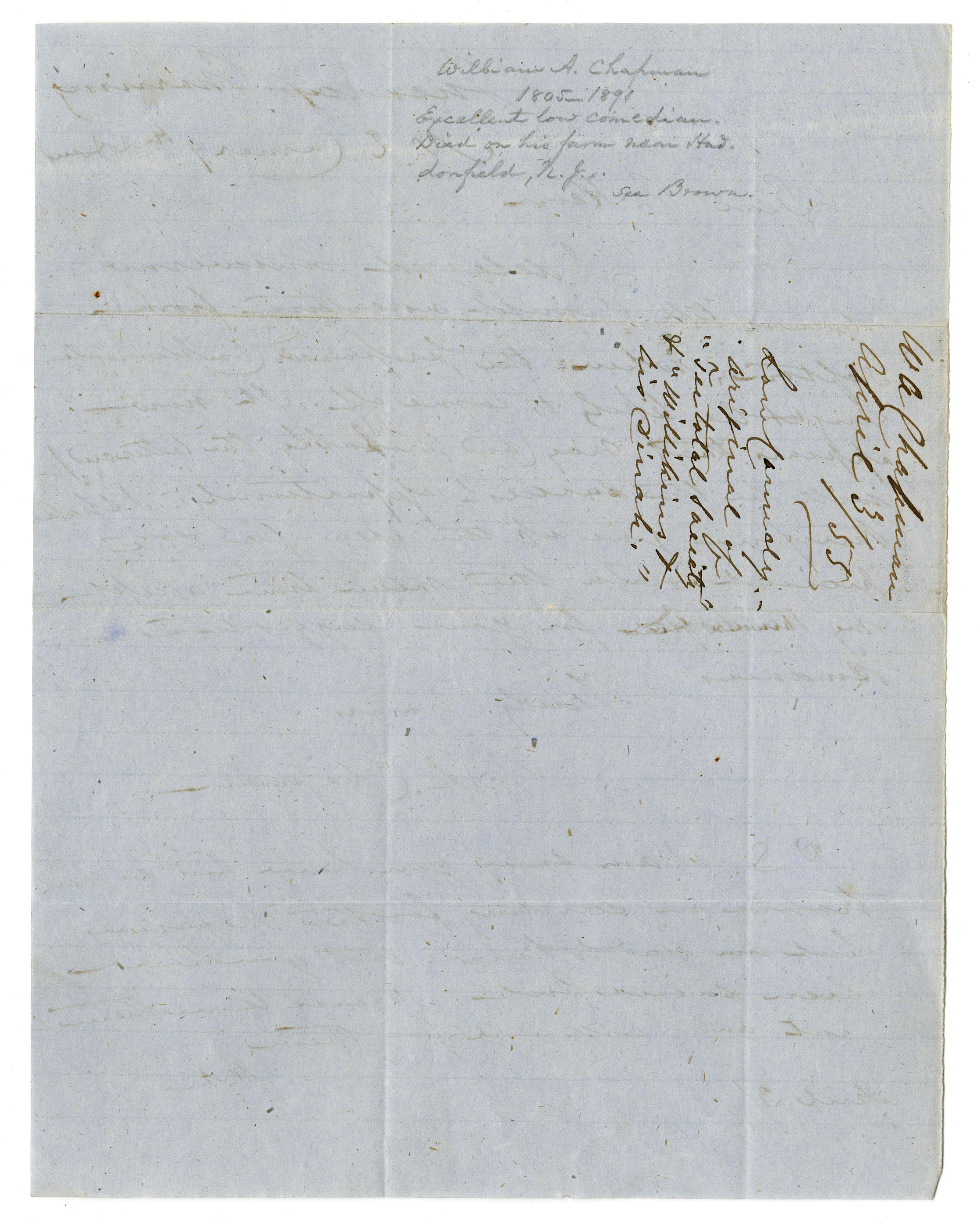
From The Simon Gratz Collection [2050B], DAMS 6590, Box 53, Folder 19
The Historical Society of Pennsylvania
Rights and Reproductions
1300 Locust St
Philadelphia PA 19107-5661
Tel 215 732 6200 ext 333
Fax 215 732 2680
rnr@hsp.org
Reproduced by permission.
Please do not copy further.
[License expires 22 September 2021]
If you had trouble reading that, here is my transcription:
|
Tuesday Morning
N. E. Corner 9th & Sound
Dear McKeon
I delayed answering yours ’till I could ascertain from Sefton,
when the proposed Complimentary might be likely to come off.
It now appears that May (and probably the latter end) will be the earliest opportunity.
I shall therefore give up the idea for the present.
In the mean time accept my thanks for your suggestions and kindness
Truly Yours,
W.A. Chapman
P.S. I am sorry you have had so much trouble in searching for the magazines
but am glad to know that you have been successful.
Please leave them out and I will call for them.
W.A.C.
April 3/
|
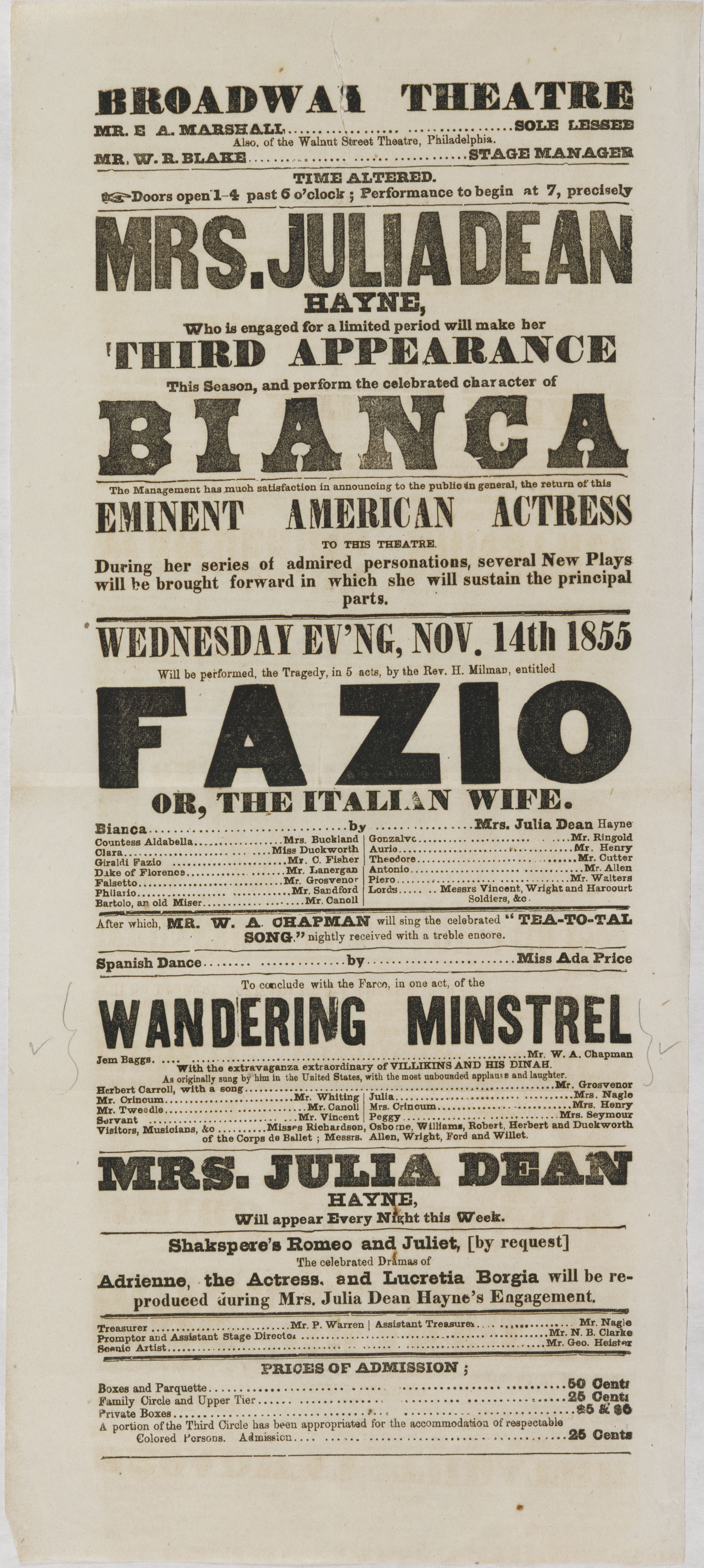
From the Simon Gratz Collection [2050B], DAMS 6591, Box 52, Folder 19
The Historical Society of Pennsylvania
Rights and Reproductions
1300 Locust St
Philadelphia PA 19107-5661
Tel 215 732 6200 ext 333
Fax 215 732 2680
rnr@hsp.org
Reproduced by permission.
Please do not copy further.
[License expires 22 September 2021]
Martha married her next husband,
William Adams Chapman, in September 1858.
She may have first encountered another branch of the Chapman family
(George, Mary, William B “Uncle Billy,” and
Caroline)
during Josh’s San Francisco gig, for they were all on tour there at the same time.
The Chapmans at that time were all associated with Philadelphia, especially with the Walnut-Street Theatre.
William Adams Chapman was born in Ripley, England, in 1805.
There was a proliferation of family members with similar names — William, William A, William B, William H —
which is why it gets confusing now to sort things out.
In any case, William Adams Chapman seems to have been somehow related to
William Chapman (1764–1839),
the creator of the first purpose-built showboat.
(It
seems that Henry Trowbridge may have moved his Albany Museum shows to a showboat in 1855, but the record is quite vague.)
William A Chapman was the leading low-comic at the
Walnut-Street Theatre in Philadelphia until his retirement in 1871.
Josh Silsbee Becomes Newsworthy Again, for the Wrong Reason.
As we saw from some of the above items,
Tom Taylor wrote Our American Cousin specifically for Josh,
but for reasons I don’t know (the published reasons make no sense),
he never performed in it, and the script remained unused for years.
Laura Keene purchased the New York rights, and her leading comic, Joseph Jefferson III, played Asa Trenchard,
the part originally written for Josh.
He worked on his part and tweaked the dialogue.
E A Sothern refused to take the part of Lord Dundreary because it was too small.
When Keene and Jefferson encouraged him to expand it, he grew enthusiastic,
and the part became his signature piece for the remainder of his life.
Two theatre owners in Philadelphia, John S Clarke and William Wheatley,
purchased the Philadelphia rights from Benjamin Webster, owner of the Adelphi Theatre in London.
So far all was probably legal.
But Clarke and Wheatley did not produce the original play.
Instead they pirated the Jefferson/Sothern rewrite.
That led to a protracted lawsuit,
which you can read about in
John Cadwalader, Cadwalader’s Cases: Being Decisions of The Hon. John Cadwalader,
Judge of the District Court of the United States for the Eastern District of Pennsylvania,
between the Years 1858 and 1879, Comprising Some Ruling Opinions on Questions of Prize
and Belligerency Arising During the Civil War, Together with Decisions in Admiralty,
in Equity and at Common Law, vol 1 (Philadelphia: Rees Welsh & Co, 1907),
“Circuit Court, November 2, 1860,” pp 343–419;
as well as at
The New-York Times, Sunday, 8 October 1865, p 3.
Martha submitted an unexpected statement.
The New-York Times, Sunday, 22 October 1865, p 3 cols 4–5:
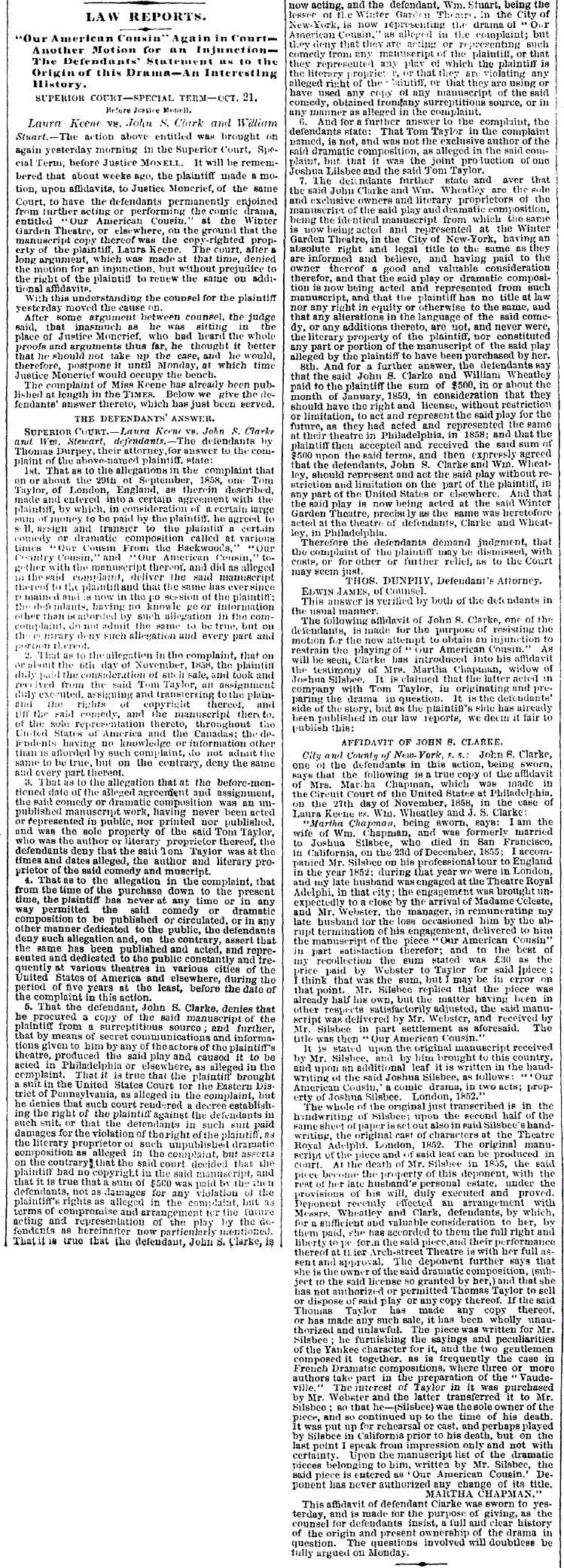
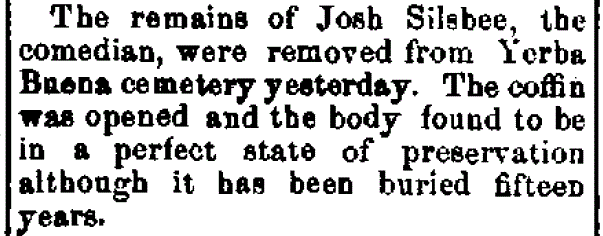
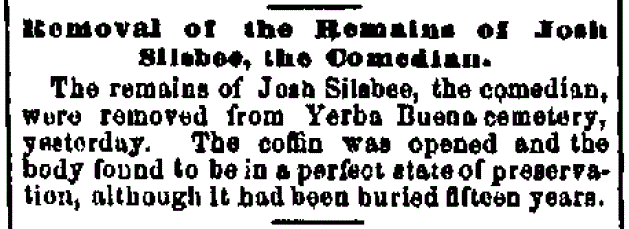
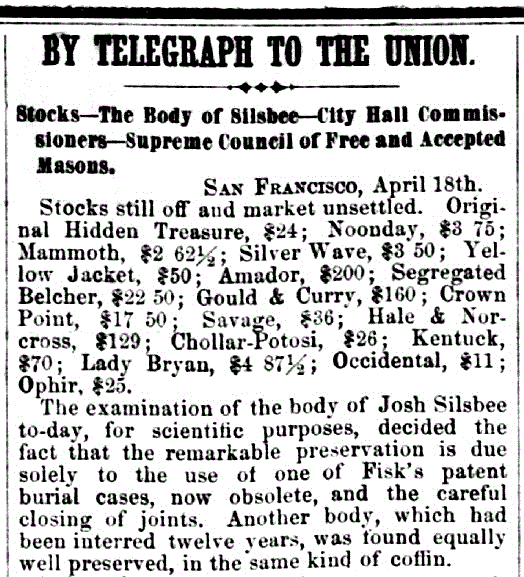

The Bloomville [NY] Mirror, Tuesday, 17 May 1870,
10 no 52, p 1 col 3:
By 1871 the transfer of the bodies to the Golden Gate Cemetery
was abandoned about a quarter of the way into the process.
The remaining bodies stayed behind, unidentified,
and there is speculation that some San Franciscans reverted to
the old practice of making soap out of the cadavers.
Back now to Martha and William.
The 1870 census gave Martha’s age as 58 rather than 60,
and it, too, gave her birth place as New York State.
When her mental powers began to fail and she could no longer remember her lines, she retired from the Walnut-Street Theatre.
She spent her remaining days at the farm she and her husband owned at Snow Hill, six miles from Haddonfield NJ,
and died in East Canaan CT while visiting her (unnamed) son-in-law on 23 August 1879 (or maybe the 20th).
Her death record stated that she and both her parents had been born in New York State,
and it gave her birth year as 1810.
The cause of death was given as “Epilepsy.”
William Chapman died on the farm on 11 March 1891.
The New-York Times, Thursday, 12 March 1891, p 5 col 5:
Just to confuse future researchers, the syndicated articles, cribbed from The New-York Times,
were printed late.
For example, here is The Critic from Washington DC, Thursday, 19 March 1891:
To confuse us even more, the official death record wrongly gives his birth as 1804 and his death as 11 March 1890.
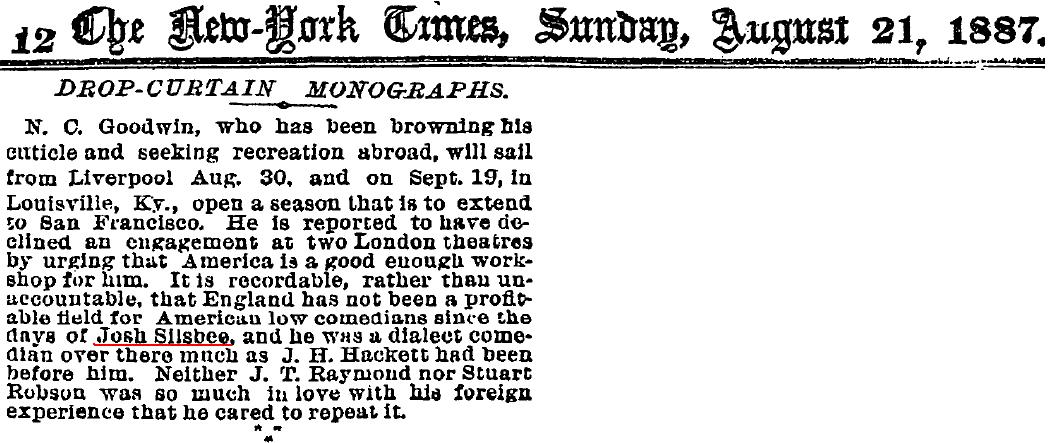
The End of the Memory.
Thanks to Donald T. Blume’s important work,
Ambrose Bierce's Civilians and Soldiers in Context: a Critical Study
(Kent State University Press, 2004),
I learned that Ambrose Bierce made reference to the memory of Josh Silsbee.
Blume, though, did not realize that Josh was an actual personage
originally buried at Yerba Buena,
nor did he understand what the state of that cemetery was at that time.
That’s forgiveable.
This called for more research.
That’s why I took it as a mandate when my friend
Serge Bromberg did
his 3D-rarities show at the Castro.
It was time to drop everything and take a vacation.
I had missed his show when he did it in
Brooklyn and I had missed it also in
Los Ángeles.
I was not about to miss it in
San Francisco.
Donald T Blume’s book convinced me not to make this a mere one-day vacation,
but a two-day vacation.
The first day of my vacation began on the library’s fifth floor,
where I pulled out the microfilm for
The Daily Examiner, Sunday, 26 June 1887, to look for Bierce’s column.
And there it was, on page 4.
Bierce’s “Prattle” column was long,
and it consisted of many stories and satirical pieces,
some of which I completely fail to understand — for multiple reasons.
I’m certain, though, that the locals at the time understood them full well.
In the midst of his other barbs were two interrelated stories about Yerba Buena,
and now that you know something of the cemetery and of Josh’s unfortunate rôle in it,
you will understand the report/fable below perfectly.

Unlike our dear friend Ambrose
(and unlike most people in the arts, and unlike almost everyone I’ve ever met, for that matter),
I do not at all believe in the supernatural,
but that doesn’t mean that I fail to appreciate the lure of ghost stories.
Not only do I enjoy them, but I wish they could be true, especially ones as precious as this.
Alas....
(Yes, I know, most of you have encountered ghosts and have had uncanny premonitions.
So have I.
But there are other explanations, believe me.)
Enough of that, though.
Donald T Blume misunderstood Bierce’s multilayered story,
and I mention this not to criticize his scholarship,
but to make a point about the disappearance of collective memory.
Note:
And thus our Josh Silsbee,
renowned comedian, has become nought more than “a ghostly manifestation of Harte’s fictional character.”
Apart from an airline stop-over in 1986,
I have visited San Francisco only twice.
The splendid and well-kept Victorian architecture that makes up the bulk of the city
is known only to those who have been there.
Many of the business blocks, though built in 1906 and after,
look as though they had been built half a century earlier than that.
Movies that are filmed in the city, for some reason,
concentrate only on the two small spots of downtown that are filled with hideous glass skyscrapers.
Those are the only parts of the city that you should avoid.
Walk around all the rest. The place is breathtaking.
Along with Detroit and Buffalo, San Francisco is one of the few US cities that can truly be termed an architectural museum.
Unfortunately, real-estate developers are busy making billions by destroying those museums, piece by piece.
Detroit and Buffalo are total wrecks.
Soon, I’m sure, nothing will be left of either of those cities.
San Francisco, though, is still viable.
My first visit there was to attend a friend’s lecture at the Italian Cultural Institute,
but, of course, I had to sneak away and spend time learning more about Josh Silsbee and Martha Trowbridge.
Little did I realize that the library where I was doing my research was resting atop
Josh’s original grave,
and that countless bodies were beneath the grounds.
Another friend, a local, gave us a tour.
Knowing of my interests, he drove us to the park surrounding the Palace of the Legion of Honor,
and said, “This is where your Silsbee is buried.”
My heavens, it was!
The Lincoln Park Golf Course had been replaced by this new park.
I looked about me at the trees and picnic grounds and rolling scenery,
and realized that we shall never know exactly where he now lies.
Soon we shall know even less,
for sooner rather than later San Francisco will be struck by another devastating earthquake,
and I wonder how much of the city will survive,
and how much of its history will survive.
Further Erosion.
I just discovered an interesting clip in a New Zealand newspaper entitled the
Nelson Evening Mail.
It celebrates the death of the Yankee stereotype.
Sorry, but since my Maori is a bit rough, I am not sure I understand the volume, issue, or date:
Rōrahi XXII, Putanga 12, 16 Kohitātea 1888, page 4.
My guess is that it means Volume 12 Number 12, 16 January 1888, page 4:
I suppose that, apart from my Trowbridge colleague, Mrs Cheryl Trowbridge-Miller, nobody has read this far.
But if you have, you’ll probably admit that this is a highly unusual story.
At first you saw lots of names, pictures, places, dates, events
that you never knew about before, that you didn’t care about,
that held no interest whatsoever for you.
You probably thought to yourself, “I can’t relate!”
But didn’t it develop?
You see, when I tell stories,
or, rather, when I relay stories,
they’re always stories that are worth getting lost in.
POSTSCRIPT — We Have a Lead!
Ancestry.com reveals that there was a family with strikingly similar names and dates.
I had run across this family before but found too many dissimilarities to consider them as possible candidates.
Now, though, Ancestry.com has filled in some more data and changed my mind completely.
Follow the paper trail and you’ll be surprised.
Using Ancestry.com as a jumping-off point, we can create the following table:
| Husband: |
Edward Russell Trowbridge
Born 18 June 1800 in Skaneateles, died 9 July or 7 September 1839 in Cincinnati.
He was the son of
Joseph Ebenezer Trowbridge (1772–1812) and
Abigail Russell (1770–1839). |
| Wife: |
Martha Matilda Allen
Born in May 1812 in Auburn, married in Auburn,
17 June 1826, at age 14.
Her parents and siblings are nowhere named.
(Ancestry.com and other genealogies leave her death, under this name, a complete blank.
Some genealogies identify her with a Mrs Chapman but don’t pursue the matter,
other records list Mrs Chapman as a completely different person,
and some just leave Mrs Trowbridge/Silsbee as a gap in the record.) |
| Children: |
• Jane Russell Trowbridge, b 8 June 1828 in Woodstock VT; m Charles Wood Palmer, 7 January 1852.
• Frederick Trowbridge, b 28 February 1833 in Skaneateles; d in infancy, 5 November 1833.
• Frances Isabel Trowbridge, b 12 January 1835 in Batavia; m Pierre Augustus Parsells, 12 January 1858. |
Of course, there are problems, each possibly resolvable, and there are also a few other issues to ponder:
• The first problem is Richmond Hill, a Buffalo author,
who recorded, second-hand, a
Mr J Trowbridge, not a Mr E R Trowbridge.
But how seriously can we take his report?
He never did his research, and clearly was under the impression
that it was Mayor Josiah Trowbridge who established a theatre in 1832!!!
Witness:
Yikes. We can discount that horrendous scholarship.
• If Mr Trowbridge’s first initial was E, that would correlate with
the portrait painted by Joseph T Harris,
in which he is in theatrical costume, as is
Mrs Trowbridge.
Were those the costumes that were used in Sheridan Knowles’s The Wife?
• If Miss Martha Matilda Allen became Mrs Martha M Trowbridge,
the dates would explain why her name was not mentioned on the bills during the first six years of her marriage.
I’m doubtful, but I wonder:
Could it be that this might explain why 1810 was listed as her official birth year, rather than 1812?
Would the later date make her appear perhaps a trifle too young to satisfy the Trowbridge reputation?
I don’t think so, but I’m not an expert in this matter, and so for the moment I‘m leaving the possibility open.
We need remember also that in the census reports of 1850 and 1860 Martha was not averse to stating her true age.
In sifting through my research files, something caught Cheryl Trowbridge-Miller’s eye.
It was a passage from Richard Plant’s “Chronology: Theatre in Ontario to 1914,”
which appeared in Ann Saddlemyer, ed, Early Stages: Theatre in Ontario 1800–1914
(Toronto, Buffalo, London: University of Toronto Press, 1990), pp 288–246:
|
30 September – 22 October 1824, York:
Mr Archbold and troupe (including Mrs Archbold, Mrs Talbot, Messrs Talbot,
Gilbert, Trowbridge, Davis, and Miss Allan) from Albany
performed at Mr Phair’s Assembly Room.
Allan MacNab, later Sir Allan MacNab, also performed with this company....
|
Is there a chance that “Miss Allan”
was actually our Martha, age 12?
Or could she have been a relation?
Or is this all coincidence, as it so often is?
We need to do some more digging, don’t we?
Cheryl just did some more digging, and her results are most promising indeed!
She just discovered a book that, surprise surprise, I already have in my collection:
Anton Wagner’s Establishing Our Boundaries: English-Canadian Theatre Criticism
(University of Toronto Press, 1999), p 66.
But she noticed something, the significance of which I had been blind to.
During the 1825–1826 winter season at York (nowadays known as Toronto),
the Gilbert-Davis-Trowbridge company received a review from William Lyon Mackenzie,
who noted of their performance of The Miller and His Men that:
“As to the ladies... if the manager would choose his loving maidens from among the
females beyond eight years of age....”
He continued: “the strength of a company is shewn to great disadvantage when young
women won’t grow old, and babies play the parts usually allotted to their mothers.”
Was Mackenzie referring to Miss Martha Matilda Allen?
At the time Martha was 13, not eight, but he could have been exaggerating to make a point,
or he could have misjudged her age.
Cheryl also found a fragmentary snippet view from the
Canadian Speech Communication Journal 4 no 8 (1972):
“ ‘Gilbert, Davis, and Trowbridge, managers of the theatre, Rochester’
set up a temporary theatre, ... particularly of Mr. and Mrs. Gilbert,
... the former Miss Allen of the Archbold troupe.
With this group came Sol Smith and his wife....”
To top that off, she also found a snippet view from
Nineteenth Century Theatre Research 3 no 2 (1975):
“Nature and Philosophy:
Brother Philip, Mr. Archbold;
Renaldo, Mr. Gilbert;
Colin, a Youth of 16 years of age, who has never seen a woman, Mrs. Talbot;
Eliza, Miss Allen;
Gertrude, Mrs. Archbold.
8 October 1824 Inchbald’s Animal....”

I’m really beginning to think that this is our Martha.
Yet here are three advertisements that one would think would include her name, but from which she is absent:
The name “Miss Allen”
never again appears in the Gilbert & Trowbridge advertisements and announcements, as far as I know,
and the name “Mrs Trowbridge” does not appear until 10 July 1832,
as far as I have been able to determine.
Despite that, Samuel Manning Welch stated that both Mr and Mrs Trowbridge
performed “in an unassuming structure located on the east side of the main avenue,
below Lafayette square, where stands the monument to our dead warriors,
on the ground now occupied by Brisbane’s Arcade Buildings”
(Welch, Home History: Recollections of Buffalo, p 363).
The building to which he referred was known as the Buffalo Theatre,
which was no longer in use by 1832!!!!!
(The last performance in that theatre was on Friday, 12 August 1831.
After that performance, there was no further mention of the building in Buffalo’s newspapers.
Had it been abandoned? Converted? Demolished?
We are left to wonder.)
So it would seem that, for reasons unknown to us, though Martha was performing,
she was kept out of the ads and write-ups.
• Why was the first child, Jane, born in Vermont rather than in New York?
Was that because her family were on tour there?
• The last child, Frances, was born in 1835, which perfectly matches Frances Silsbee’s age in the 1850 census.
And it perfectly matches more than that!
On Monday, 5 January 1835, the managers of the Buffalo Theatre announced a temporary closure
“in consequence of the necessity of Mrs. Trowbridge’s present retirement.
Mrs. Trowbridge has, however, has kindly consented to remain during the six nights the Theatre will continue open.”
She played repertory (including Juliet!) through Saturday, 10 January.
Frances Isabel Trowbridge was born on Monday, 12 January 1835, in Batavia,
and her birth record lists her parents as Edward Russell Trowbridge and Martha Matilda Allen.
This exactly matches the recollection provided by Samuel M Welch, quoted above,
and which bears repeating here, that Mrs Trowbridge
“acted a leading part here in Buffalo on a Saturday evening and again in Batavia,
on the Monday evening following;
in the meantime, between the two dramatic presentations,
she rode in the stage coach (no railways then) forty miles, and also presented her lord with an heir.”
As far as I’m concerned, this clinches the matter.
This is too much for coincidence.
This takes my breath away.
Welch’s unreferenced and casual recollection was not something I thought I could confirm, at least not easily.
But acting only on a hunch based on the 1850 census from Philadelphia,
I put the newspaper article, which no one but me has read since 1835,
together with Welch’s reminiscence, and I put both together with a birth record,
and it all falls together seamlessly because it always belonged together.
Amazing. A hit like that doesn’t happen too many times over the course of one’s life.
We may wonder, though, about one possible problem: the ability or willingness of an itinerant troupe in 1835
to brave the Western New York lake-effect elements in January to travel 40 miles by stagecoach.
This is not a problem.
As we can see from the records of the time,
that was quite common.
Unlike us, people back then did not complain and make excuses.
If there was a job to do, they did it, and the weather was not an issue.
Anyway, now what we need to do is dig up the Batavia newspapers from 12–13 January 1835
to see if the show really went on as scheduled.
Wouldn’t that be an interesting project? Yes?
Also, the short life of infant Frederick corresponds to a period of Buffalo’s history
that had an unexpected dearth of theatrical entertainments,
even though theatricals were freely permitted by law at that time.
I never understood the reason for that until now.
• There is a problem with Mr Trowbridge’s death date.
The Cleveland Daily Herald and Gazette in its 24 July 1839 issue reported
that our Mr Trowbridge had passed away in Cincinnati on 9 July 1939.
Ancestry.com, on the other hand, notes, without documentation,
that Edward Russell Trowbridge passed away in Cincinnati on 7 September 1839.
That is beyond doubt a misreading of the July date.
You see, while most Americans would abbreviate July ninth 1839 as 7/9/1839,
there is a large minority of Americans (myself included) who follow the convention used everywhere else in the world,
by which 7/9/1839 would mean the seventh of September 1839.
• There’s even more.
Dorothy’s Maltby Manuscript
lists this same family, and gives Edward’s death date as 9 July 1839 in Cincinnati.
She goes on to say that Martha later married a Chapman,
and “removed to the South, taking her youngest daughter by her first husband.”
That threw me off track for years.
Martha did not move to the South.
But she did move south — to Philadelphia.
See how the tiniest mistake makes such a big difference?
Let’s take a look at something interesting:
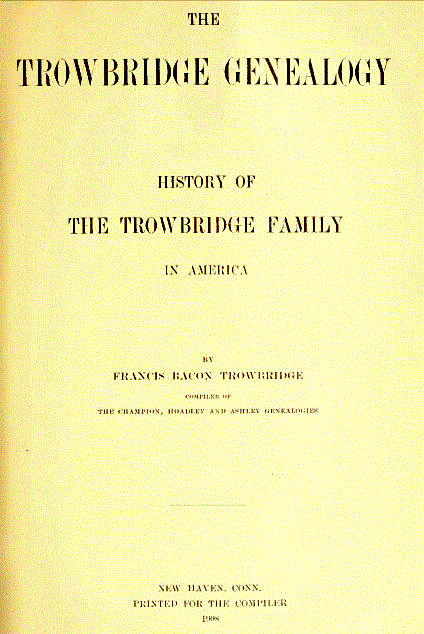
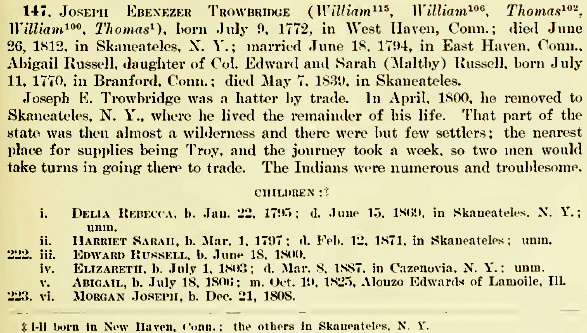
“The Indians were numerous and troublesome.”
Well, who can blame them?
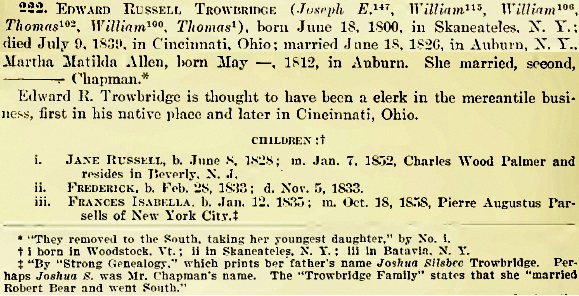
Robert Bear? Who on earth was Robert Bear?
Cheryl Trowbridge-Miller (not a direct descendant)
assures me that there were Bear/Beer/Bears/Beers in her line as well,
suggesting that something, once again, got garbled in the published accounts.
She referred me also to the
Genealogy’s predecessor,
The Trowbridge Family (1872)
by the Reverend F W Chapman (yes):
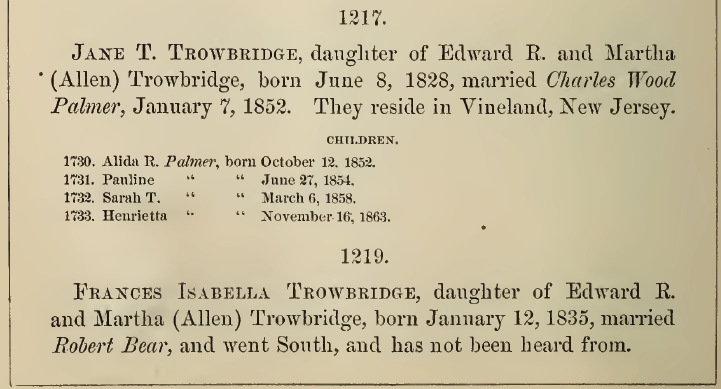
And now let us turn back to the successor volume from 1908:
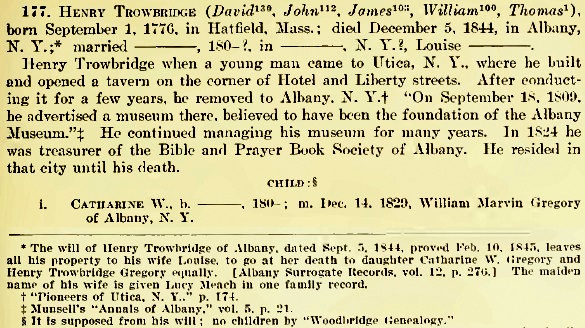
See? I told you that would be interesting.
Let’s go through some of this, one step at a time.
In the official
Trowbridge Genealogy,
Edward was listed as “thought to have been a clerk in the mercantile business,
first in his native place and later in Cincinnati, Ohio.”
Of course, neither his trade (clerk in the mercantile business) nor his residence in his native place (Skaneateles)
matches the itinerant theatrical actor-manager Mr Trowbridge whom we now know so well,
whom the capsule biographies claimed had been born in New Haven.
Nonetheless, the official genealogy is filled with the inevitable mistakes and omissions,
as are the books devoted to capsule biographies.
We are left to wonder:
Did Gilbert & Trowbridge ever perform in Skaneateles?
I’m willing to wager that they avoided that tour stop,
for fear that the shameful truth would be discovered about Edward and Martha’s disgraceful profession.
I’m willing to wager that, after splitting off from Smith & Davis,
they never even performed again in nearby Auburn.
That would explain the cover story about the mercantile business
as well as the cover stories about New Haven and England.
I must congratulate the couple on their cleverness.
Edward was on stage at least as early as August 1824,
and Martha probably at the same time,
but I couldn’t put the pieces together until January 2011.
So the secret remained a secret for 186 years.
Considering that most people can’t keep a secret for 186 minutes,
this is quite some accomplishment.
Little could they have guessed that nearly two centuries later
a hobbyist would be so obsessed by the mystery they created
to devote thousands of hours and thousands of dollars
for a decade and a half to unravel their web of deceit.
What will their parents think when they stumble upon this web essay?
It’s good to have the info about Henry Trowbridge,
and this finally explains the connection with the Meech family,
here spelled Meach.
Unfortunately, that is the only connection it provides.
Note also the page headers:

When I first ran across that, I thought it was just one of those crazy coincidences that we find in genealogies all the time:
remarkable similarities in names and dates and places, especially among families that have similar backgrounds and ancestries.
But no, this is not a coincidence.
This is a mistake founded upon guesses and false assumptions.
In any case, this might make sense of the (mistaken?) biographical entries
that give Josh’s birth place as
Litchfield.
Which of Martha’s sons-in-law was residing in East Canaan in August 1879?
Pierre Augustus Parsells or Charles Wood Palmer?
According to the 1880 census, Pierre Augustus Parsells and his wife Frances were living in New Canaan.
According to a librarian at the Connecticut Historical Society, the “Hale Headstone Index”
lists a “Chapman, Martha, wife of W.A., died Aug. 20, 1879, age 69 yrs.” at the Riverside Cemetery in Norwalk,
which is quite some distance away from any of the Canaans.
Making this more interesting is the 1887 directory which lists Pierre A Parsells
as living at 33 North Avenue in Norwalk.
Ownership of a plot of land might be the reason for the discordance between place of death and final resting place.
Make of all this what you will.
I had previously run across similar references to the mercantile clerk of Skaneateles named Edward Russell Trowbridge,
and to his wife Martha Matilda Allen,
as well as to the surprisingly named “Joshua Silsbee Trowbridge,”
but I dismissed them because of the discrepancies.
Now, though, we have at last solved the mystery.
That took me, what, fifteen years?
So now, after several years of scratching my head, I’m almost certain that Harris’s dual portraits
are indeed our Mr & Mrs Trowbridge.
Now it’s time to trace the descendants. Won’t that be fun?
There are still a few remaining mysteries:
Who were Martha’s parents and siblings?
And who were Mr & Mrs Gilbert?
I’ve been trying since 1994 to trace them, without success.
While all Trowbridges are related, that certainly does not hold true for the infinitely more populous Gilberts.
LeRoy Wilson Kingman, in his ultra-rare book on
Owego; Some Account of the Early Settlement of the Village in Tioga County, N.Y., Called Ah-wa-ga by the Indians,
Which Name Was Corrupted by Gradual Evolution into Owago, Owego, Owegy and Finally Owego
(Owego: Owego Gazette Office, 1907), related some stories,
and in those stories are two clues:
That’s a little help.
Not much, but better than nothing.
Before we proceed with the story, let’s add some glosses to the text.
“The company was composed of Gilbert, Trowbridge, Powell, and Archibald and their wives, with one or two others.”
John H Powell had been a mystery.
All I knew about him was that he had been given a benefit at the Buffalo Theatre on Tuesday, 2 August 1831.
Thank you, LeRoy Wilson Kingman, for filling us in a little bit!
Kingman misprints Archbold’s name as Archibald, which is to be expected, as the pronounciation is similar or identical.
He seems not to have been an Englishman, but an Irishman,
though he specialized in English drama both in Ireland and in the States,
which would lead to the misperception or misrecollection.
Really not so bad for a 74-year-old memory.
Mrs Trowbridge-Silsbee-Chapman, as we know, did not die in San Francisco in 1880.
Her husband died in San Francisco, and she died close to 1880.
Kingman jumbled the data, as he was surely writing from imperfect memory.
The slap-dash staging and effects are on par with what many troupes utilize nowadays.
Why were so many townsfolk opposed to the theatre?
The reason was more than dissipation.
When you get some leisure time, look up the term “third tier.”
That will begin to explain the problem.
Clearly there was no “third tier” in Owego, but the very concept tarnished theatre’s reputation for centuries,
and I argue that it has yet to recover.
I have no other information about Henry Vaughn.
Sam Lathrop appeared six years later at the Columbus Theatre in Columbus, Ohio,
under Mr Kent’s management.
Kore? That was
Jacob C Kore,
but that’s the limit of my knowledge.
The problem, of course, is that Gilbert is such a common name.
Thanks to Kingman, we can be reasonably certain that his initials were “R T,”
and I really thought that having those initials would help,
but they surprisingly get me nowhere.
Worse, I have yet to find any possible candidate who died in or around 1849.
(And just so that you don’t fall into the same trap that others have fallen into,
our Mr Gilbert was NOT NOT NOT NOT NOT the famous John Gibbs Gilbert,
no matter what was written in the
History of Concord.
Our Mr Gilbert had already been a married actor-manager
at the time that the yet-to-be-famous John Gibbs Gilbert
was still a teenage apprentice in his uncle’s dry-goods shop.)
Just for the heck of it, we can explore some Gilberts.
Almost immediately we discover a Mr Gilbert who appeared as a dancer at the theatre in Milwaukee in April 1839,
and who appeared there with his wife in 1850.
And they performed elsewhere, too, including Buffalo.
But those were different Gilberts.
Here’s what Thomas Allston Brown had to say,
though he misprinted “1839” as “1849,”
which was enough to throw me off course for a month or so.
Well, back to the old drawing board.
The Gilberts are the one major gap remaining in my research.
Once I identify them, I’ll have a book ready for publication.
Of course, Cheryl Trowbridge-Miller once again pointed out the obvious.
I have a depressing propensity for missing the obvious.
She referred me to a different section of the Kingman’s Owego:
All right.
That takes our Mr R T Gilbert right up to late August 1847.
No mention of the Mrs, for whatever reason.
Remember Mr William M Fleming, who performed with Josh Silsbee in October 1853?
Well, here he is, six years earlier, performing with Mr Gilbert in Potter’s troupe.
There’s a lead in there somewhere, but I’m not sure where.
When did Gilbert hook up with
John Sinclair Potter?
Could that have been in 1836?
Was he a full partner?
When and why did the partnership end?
We can turn again to
Allston Brown’s History,
but I’m still stuck,
though I cannot help but notice that Potter was at one time working with Edwin Dean:
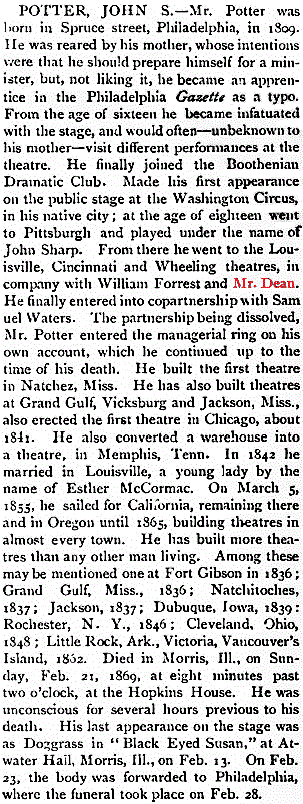
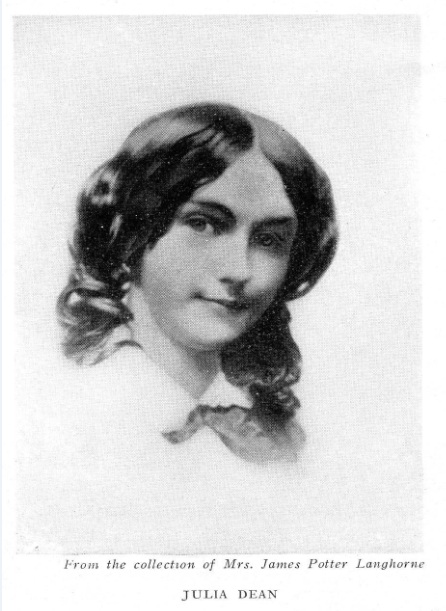
Image from Constance Rourke’s Troupers of the Gold Coast; or, The Rise of Lotta Crabtree
(NY: Harcourt, Brace & Co, 1928).
Now you see why everyone fell in love with her?
Including me. Why is it that all the gals I fall in love with
died a century before I was born?
(I’m entirely out of place in this
cynical, apathetic, beer-obsessed, caffeine-intoxicated,
tattooed, pierced, self-absorbed, “spiritual,”
never-walk-only-drive, what’s-your-sign?-oh-that-explains-everything,
oh-I’m-so-stressed-out, anti-depressant-pill-popping,
don’t-talk-to-me-I’m-listening-to-my-iPod, I-need-to-see-my-therapist,
why-do-you-care-about-that?-that’s-so-old,
I-don’t-want-to-get-involved, why-don’t-all-those-homeless-people-just-get-a-job,
oh-come-on-just-get-over-it, pull-yourself-together, we-all-create-our-own-reality,
electronically-amplified-“music,” not-in-my-job-description,
put-it-on-my-credit-card, rent-to-own-your-very-own-HDTV-at-7000%-suggested-retail-price,
celebrity-idol-culture age
dominated by bulldozers-and-Bilderberg-and-Trilateral-
and-environmental-devastation-all-in-the-name-of-corporate-tax-free-profits-
so-long-as-we-can-get-people-arguing-over-
I’m-a-liberal-and-you’re-a-conservative-or-vice-versa-
refusing-to-acknowledge-that-both-sides-are-war-mongering-
death-penalty-for-the-innocent-poison-the-rivers-and-blast-the-mountains-
and-kill-the-oceans-and-lakes-psychos.)
Julia was related, by marriage, to the Chapman family,
which just goes to show you....
Julia’s niece was also her namesake,
Julia Dean (13 May 1878 – 17 October 1952),
another prominent stage and movie performer
whom you probably saw in The Curse of the Cat People if nothing else.
Did anyone in the Dean family keep the records of those days?
If so, please write to me!!! Thanks!
For what it’s worth, this what I’m currently doing with my hunches, which are probably all wrong,
though they might make good starting points.
| • 1822: |
R T Gilbert is a teenage youth living in Albany,
frequenting Henry Trowbridge’s Albany Museum
where he falls in love with the stage. |
| • September 1822: |
Alec Archbold and the Talbots flee New York City to escape the yellow fever, and land in Albany. |
| • September 1822: |
Gilbert asks to go on the road to apprentice with them, and is accepted.
See also the
Wayne Sentinel (Palmyra NY) 1 no 32, p 3 col 2. |
| • Early 1824: |
Edward Russell Trowbridge visits his distant cousin
Henry in Albany, sees the Museum, and also falls in love with the stage. |
| • Early 1824: |
Henry introduces Edward to itinerant actor-manager
William Davis, who takes Edward on as an apprentice.
Henry and William invent the story about Edward’s
New Haven origin, for that is where many or most Trowbridges were living.
With such a cover story, others in the trade would never connect Edward with Skaneateles. |
| • After May 1824 but before August 1824: |
Davis & Trowbridge join Archbold & Talbot,
who have also by this time added a
Mr Harrington and a Mr & Mrs Clarendon.
(See also
this ad.) |
| • Summer or Autumn 1824: |
Joining the touring company is 12-year-old Martha Matilda Allen.
Even in 1824 it was unheard-of for someone so young to travel without being accompanied by family,
and so, unless we are confusing one person with another, there is no doubt but that her family, or appointed guardians, were with her.
Of course, this leaves open the probability that her appointed guardians were among the Archbold & Talbot cast.
Clarendon? Harrington? Probably not.
What do we know, and what do we not know?
We know that in Auburn in the 1830 census there was a John H Allen (age 30–39),
with a wife (age 30–39) and a daughter (under the age of five).
We know that NEXT DOOR to the John H Allen family was Aaron Trowbridge (age 30–39),
with a wife (age 30–39), a son (age 5–9), and a daughter (under the age of five).
About six houses away was
Reverend Parley Allen (age 60–69 —
click here for military record) and his wife.
We discover that his wife,
Catherine “Katie” Ter Bush, was born on 3 January 1773,
which would have made her 57 years of age by the time of the 1830 census.
Living at home with Parley and Katie in 1830 were six daughters
(one age 36, one age 20–29, two age 15–19, two age 10–14, and one age 5–9),
and a son (age 15–19).
Genealogy.com
names their children:
Sally (b 1794), Kathryn, Jane, Anne, William, Ruth Honore/Honour (1812–1894),
Lavina, Samantha, Diantha (1819–1893), and at least three other daughters, names unknown.
Is one of the Unknowns actually Martha?
Or are we grasping for straws?
I think we can discount old
Parley,
unless, of course, Martha is Parley’s grandchild.
But let’s look a bit further at young John.
Thanks to Cheryl Trowbridge, we now know that in the 1820 census for the Town of Aurelius
(the Village of Auburn didn’t incorporate until 1815;
prior to that it was just a part of the Town of Aurelius)
there was a John Allen who had TWO daughters!
Was this the same person?
We probably know that John H Allen’s wife was named Jane,
because in the 1850 census for Auburn there is a Jane Allen listed, age 55.
Remember that Edward and Martha’s first child was named Jane as well,
and it was tradition that the first daughter be named for the mother’s mother.
So it is reasonable to assume that the 55-year-old Jane was John’s widow.
It is reasonable, also, to assume that Martha was John and Jane’s first child.
Since John lived next door to an Aaron Trowbridge,
it is reasonable to assume that the two families were close.
Before we go further, let’s see if we can figure out who Martha’s touring guardian was.
So let’s review the known Archbold & Talbot cast members in
New York City on Tuesday, 3 September 1822:
• Mr Stone
• Mr Lamb
• Mr Talbot
• Mr Roberts
• Mr Simpson
• Mrs Legg
• Mrs Talbot
• Mr Williams
• Mr Ritter
• Mr Saunders
• Mr Garner
• Mr Archbold
There had been some changes by the time
they opened in Albany, just days later:
• Mr Talbot
• Mrs Talbot
• Mr Simpson
• Mr Williamson
• Mr Richards
• Mr Lamb
• Mr Saunders
• Mr Cook
• Mr Archbold
• Mr Gilbert
• Miss Odell
• Mrs Dorion
By the time they reached
Palmyra in May 1824, the cast appear to have been reduced drastically:
• Mr Archbold
• Mr Clarendon
• Mr Talbot
• Mr Harrington
• Mr Gilbert
• Mrs Talbot
By August 1824 in Buffalo one further cast member was being announced, though, considering that Mr Archbold had a daughter who had been born in about 1817, I strongly suspect this next performer had been there all along:
• Mrs Archbold
At the end of September 1824, performing in York (modern-day Toronto),
the cast had been altered once again, but we have only a partial listing:
• Mr Archbold
• Mrs Archbold
• Mrs Talbot
• Mr Gilbert
• Mr Trowbridge
• Mr Davis
• Miss Allen
• Allan McNab
The coincidence of the penultimate surname and the ultimate given name
is probably just a coincidence.
What do we make of this?
I don’t know.
Could Martha’s appointed guardian have been Edward?
How likely was that?
Auburn and Skaneateles were neighbors.
The Allens and the Trowbridges seem to have been close.
Nonetheless, what parent would possibly consider appointing
a 24-year-old single male to be the guardian of
a 12-year-old girl,
regardless of how close or justifiably trusted that
24-year-old single male may be?
Strange, isn’t it?
We can probably rule Edward out.
There is also the possibility, of course,
that Martha’s parents were not included in the 1830 Auburn census.
None of this makes much sense, and I really don’t know how to proceed.
That’s why I let my cyber-friend Cheryl proceed for me.
She’s so much better at this than I am!
She found two interesting listings in the 1820 Aurelius census:
• Betsey Allen (presumably widowed)
with a daughter between the ages of 10 and 15, and a second daughter under the age of 10.
• Three houses away was a George Gilbert,
in whose household there were two males between 26 and 44,
three between 16 and 25, and one under 10;
one female (presumably his wife) between 26 and 44,
and one between 16 and 25.
One of the above Gilberts (George?) was engaged in agriculture,
and four of the above (his sons?) were engaged in commerce.
Coincidences?
If I were a mystery-mongering TV producer, I’d say “You decide.”
Whenever anyone presents you with carefully pre-selected data designed to befuddle and says
“You decide,” you should know that you’ve just been tricked.
I, on the other hand, try never to trick people,
which is why I refuse to go into sales, which is why I’m poor.
So I’ll simply say: “Heck if I know.”
Well, Cheryl just found more.
Reverend Parley’s first daughter Sarah/Sally married a fellow named Booth/Boothe,
and Sarah/Sally’s first son was consequently named Parley Boothe.
NEXT DOOR to Sarah/Sally Boothe (56) in 1850 were
Horace Gilbert (26), his wife Jane (23), their daughter Sarah (5),
and Jane’s mother Sarah Allen (43),
all living in the home of Betsey Goodrich (71).
So there was DEFINITELY a connection between the Allen family and the Gilbert family,
and so now I’m ALMOST certain that little 12-year-old Miss Martha
went on tour only because her relative Master Gilbert told her
“come along and we’ll all have fun!”
That might also explain her early marriage —
not only did she and Edward like each other,
but a wedding ring displayed on a finger could work wonders at keeping the mashers at bay. |
| • Autumn 1824: |
Though Archbold and the Talbots are still the leads, the troupe is known, informally,
as Gilbert, Davis & Trowbridge, with a home base, for the time being, in Rochester.
This suggests that Gilbert, Davis & Trowbridge did not perform exclusively with Archbold & Talbot,
but also did shows on their own. |
| • Between September 1824 and March 1825: |
R T Gilbert gets married.
This should be the lead we’re looking for.
All we’d need to do is find that marriage record,
and we’d know precisely who Mr & Mrs Gilbert were.
Why can’t we find that marriage record ANYWHERE????? |
| • Early 1826: |
They hit the big time!
Now that Archbold & Talbot have wandered off,
leaving Gilbert, Davis & Trowbridge behind,
Davis manœuvers to attach the company to the estimable
Sol Smith,
forming the Smith & Davis company.
The fortunes do not last more than a few weeks or months, as Smith quickly tires of Davis’s antics. |
| • May 1826: |
Alec Archbold opens the Washington Museum Theatre at 48 Market Street in Philadelphia. |
| • Between May 1826 and June 1827: |
Davis leaves the troupe and eventually ends up in Missouri and Louisiana. |
| • 17 June 1826: |
Edward and Martha marry, at a frightfully young age.
Despite all you learned in school, it was highly unusual for a 14-year-old to marry.
The common marriage age, then as now, was early to mid-20s.
How on earth did this strange marriage come about?
Well, might this marriage have been arranged?
Cheryl Trowbridge-Miller dug up two different online scans of Henry Hall’s
History of Auburn from 1869.
Apparently the Allen family were quite prominent, and there was even a
Captain Trowbridge Allen!!!!!
This use of Trowbridge as a first name rather than a surname might be unique.
This suggests that the two families were close,
which further suggests that the marriage between Edward and Martha was indeed arranged.
It crossed my mind that theirs may have been a shot-gun wedding, but I don’t think so.
Their first known child was born in 1828, not 1826 —
though, of course, that does not discount the possibility of an earlier child who may have been stillborn.
Whatever the truth of the matter, Mr & Mrs Trowbridge worked together so well
that I doubt they had been brought together by any such unpleasant pressure.
Let’s think this through.
If Martha had been on tour from age 12 or younger, then her parents (guardians?) certainly knew.
Yet the larger Trowbridge family seem never to have known.
The true nature of the itinerant career was kept secret not from the Allen family,
but only from the Trowbridge family.
My guess is that Martha had been around enough Brits to do a convincing English accent.
(Were her grandparents British?)
My guess is that it was William and Edward who together fabricated the cover story
about Martha’s English birth so that fellow thespians would never connect her with Auburn
or any other place in New York,
and possibly (assuming the marriage had not been arranged after all)
so that Edward’s family would never enquire of their in-law
from travelers who came into town from neighboring Auburn.
My guess is that Martha found the story useful enough never to retract it.
We should also keep something else in mind.
In no report, published or unpublished, official or unofficial, that I can locate,
are Martha’s parents named.
Should we take that as a hint that she was not overly happy about her family?
If her dad was so anxious to dump her off on the first guy who came along,
that might explain her silence on the issue. Yes?
There are so many possibilities here, and I don’t know what to do with them. |
| • Late 1820s: |
Alec Archbold falls upon hard times. |
| • 1829: |
Alec Archbold dies of consumption in Poughkeepsie. |
| • Late 1835: |
Gilbert & Trowbridge disband,
and both couples join the Dean & McKinney company,
which opens the Eagle Street Theatre in Buffalo and the Columbus Theatre in Columbus.
The Gilberts and the Trowbridges settle in Columbus, or at least they seem to.
Cheryl just discovered why we can never find their abodes:
The thespians lodged with Edwin Dean in Buffalo!
Perhaps Gilbert and Trowbridge had no homes from 1822/1824 on, and simply lodged wherever they went.
The one thespian couple that seems not to have lodged with Edwin Dean in Buffalo
was the Gilbert couple.
They were not at the Eagle Street Theatre’s opening in June 1835,
though they were at the Columbus Theatre’s opening in December 1835. |
| • 29 May 1837: |
Cheryl just discovered this (27 Feb 2011).
Alfred Theodore Andreas,
History of Chicago: From the Earliest Period to the Present Time, Volume 1
(Chicago: The Lakeside Press, R R Donnelley & Sons, 1884), p 473:
Wow! Thank you Cheryl! |
| • After December 1835, but before December 1836: |
The Gilberts vanish from the record, without explanation.
You will see in this link reference to a Mr M J Gilbert.
That was somebody else.
Yes, somebody in theatre, somebody who built the City Hall Theatre,
but it was somebody else, definitely.
Mr M J had a completely different biography,
and this is his only overlap with our Gilberts and Trowbridges. |
| • 1840: |
Cheryl Trowbridge-Miller discovered that in the 1840 Cleveland census
there was a Mrs R Gilbert, over 40 but under 50, living alone.
Could that be our Mrs Gilbert?
She would have been a bit older than Mr Gilbert,
which is quite common, but not in this context.
What mature woman would risk abandoning any hope of stability
in order to run off with a young apprentice?
Well, some would, I’m sure.
So that may be what happened.
No children are listed.
Did they not have children?
Or did the children not survive?
Or did other family members take custody? |
| August 1847: |
Mr R T Gilbert
is back in Owego, performing as part of John Sinclair Potter’s company,
alongside Mrs Potter,
William M Fleming (b Danbury CT 1817, d NYC 7 May 1866),
a Mr & Mrs Mehan,
a Mr & Mrs Donovan,
and a Mr Pemberton.
Can someone from Owego dig through the microfilms and get some details?
No one has yet done a full-scale study of Potter, and it’s high time that somebody did.
Go for it.
If you’re in school, start on the project.
When you get to college, you can get a PhD for it.
Then go on book-signing tours and make yourself a lot of money.
Just do it, please. |
Now let’s look at a basic reference.
Note the wording of the
“TROWBRIDGE, MR.” listing.
It is written as though there is also an entry for “GILBERT, MR.,”
but there isn’t.
He lists all sorts of other Gilberts, but not our Mr & Mrs R T Gilbert.
Thomas Allston Brown knew Josh Silsbee and Martha personally and got the stories of their careers from them directly.
He never knew the Gilberts, and clearly the book was rushed to press before he could gather the needed information.
Wanna see something delicious?
Take a look at The New York Daily Times, Saturday, 27 December 1851, p 2 col 6:
Then something happened, something that confused cataloguers over a hundred years later:
And that are it.
Any other hopes?
Well, there’s a vanishingly small chance that some remnants are rotting in trunks stored in descendants’ attics.
Descendants of whom?
Here are a few candidates.
The House of Representatives noted that the Honorable Mr Nabers
had been furnished a subscription from December 1851 through December 1852.
Are his old newspapers still on file somewhere?
According to the
Adams Family Genealogy Forum, “William Edward Blakeney, born Peekskill, Dec. 28, 1820, d. June 3, 1903....
There was much in the mental ability of Dr. W. E. Blakeney, D. D. S., to be appreciated.
His vein of humor was inexhaustible and he was never at a loss for something amusing, not only to himself but to those around him....
I think it was in the fifties that he edited a paper in New York called the New York Dutchman.”
Then we have a passing reference in
The Humors of Falconbridge that Jonathan Falconbridge Kelly (the aforementioned biographer of Yankee comic Dan Marble)
edited the New-York Dutchman for about four months in 1854.
And here’s another clue, from The New-York Daily Times, Saturday, 7 July 1855, p 4 col 6.
The editor of the New-York Dutchman endorsed a snake-oil cure-all.
Because of that, we have his name:

Finally, John Homer French, in
Gazetteer of the State of New York (1860), noted on page 446 that the New-York Dutchman
was a publication of E Weston & Co, but that it was defunct.
Then in October 1860
(or 23 October 1865?)
Richard M Griffin
and a relative, E Griffin, became publishers and editors of another Albany newspaper,
the Evening Post.
The Evening Post continued publication through 1895,
and then I have no idea what happened.
Maybe the successor to the successor to the successor to the successor of the Evening Post
might have the back issues of the Dutchman in storage somewhere?
As with all cities, Albany has had more newspapers than anyone has been able to tally.
Where did they all go?
“Journalists and Journalism in Albany County,” George Rogers Howell & Jonathan Tenney, eds,
Bi-Centennial History of Albany: History of the County of Albany, N. Y., from 1609 to 1886.
With Portraits, Biographies and Illustrations (NY: W W Munsell & Co Publishers, 1886), p 377:

If you can locate the Saturday, 27 December 1851,
issue of the New-York Dutchman,
let me know. You’ll be my friend for life.
P.P.S. On the off-chance
that doing research like this fascinates you,
you’ll flunk all your history courses
because you won’t be able to memorize miserably written and overpriced vigenary textbooks,
and because your profs couldn’t care less about fun stuff like the above.
Also, if you enjoy devoting your time to research and writing activities such as this,
you should look forward to a life of minimum-wage jobs as janitor or clerk,
working for a series of sadistic maniacs,
because as far as any employer is concerned, you have no other job qualifications —
unless, of course, you just happen to luck out only because of connections.
Also, your microcephalic TV-addicted imagination-impaired
neighbors will be endlessly suspicious of you because you never hang out with them
to drink beer and watch stretched-image football games on the big-screen HDTV
at the foul noisy stale smelly local bar.
Instead you spend your time at the libraries and historical societies
and at night you keep to yourself in your little apartment to piece together your notes,
which convinces all your neighbors that you’re a social misfit and up to some nefarious activities,
probably terrorism or drug-running or arms-smuggling or child molestation
or S&M or other various deviant sexual activities
(the only possibilities they can think of — do you wonder why?),
and they’ll call the cops who will smarten you up and run you out of town.
Then they boast that they’re “keeping the neighborhood safe” by being “tough on crime.”
And nowadays school children who exhibit intense interests in such scholarly endeavors
are diagnosed as having ADD and are pumped full of Ritalin.
Back in the old days ADD had a different name: “gifted.”
And that’s just the way it’s got to be,
because we’ve become a society of lunatics.
P.P.P.S. When you do research like this,
you’ll also get people fired from their jobs.
My cat’s name is Mrs Trowbridge.
That led to the following conversation at a check-out stand:
|
CASHIER: How are you tonight?
ME: I’m happy, because I finally learned my cat’s middle name.
CASHIER: Oh, he told you?
ME: It’s a she. And no, I kept asking but she would never tell me.
CASHIER: They do like to keep things to themselves.
ME: But I found out! I found out!
CASHIER: And what, might I ask, is your cat’s middle name?
ME: Matilda!
CASHIER: Of course! My cat has a first name and a last name, but I don’t know if he has a middle name.
ME: And what’s your cat’s name?
CASHIER: Elwood Blues.
|
 |
That was the last I ever saw of that cashier.
I suppose some sputtering short-fused manager witnessed that exchange on the video monitor and
decided to show her who was boss.
